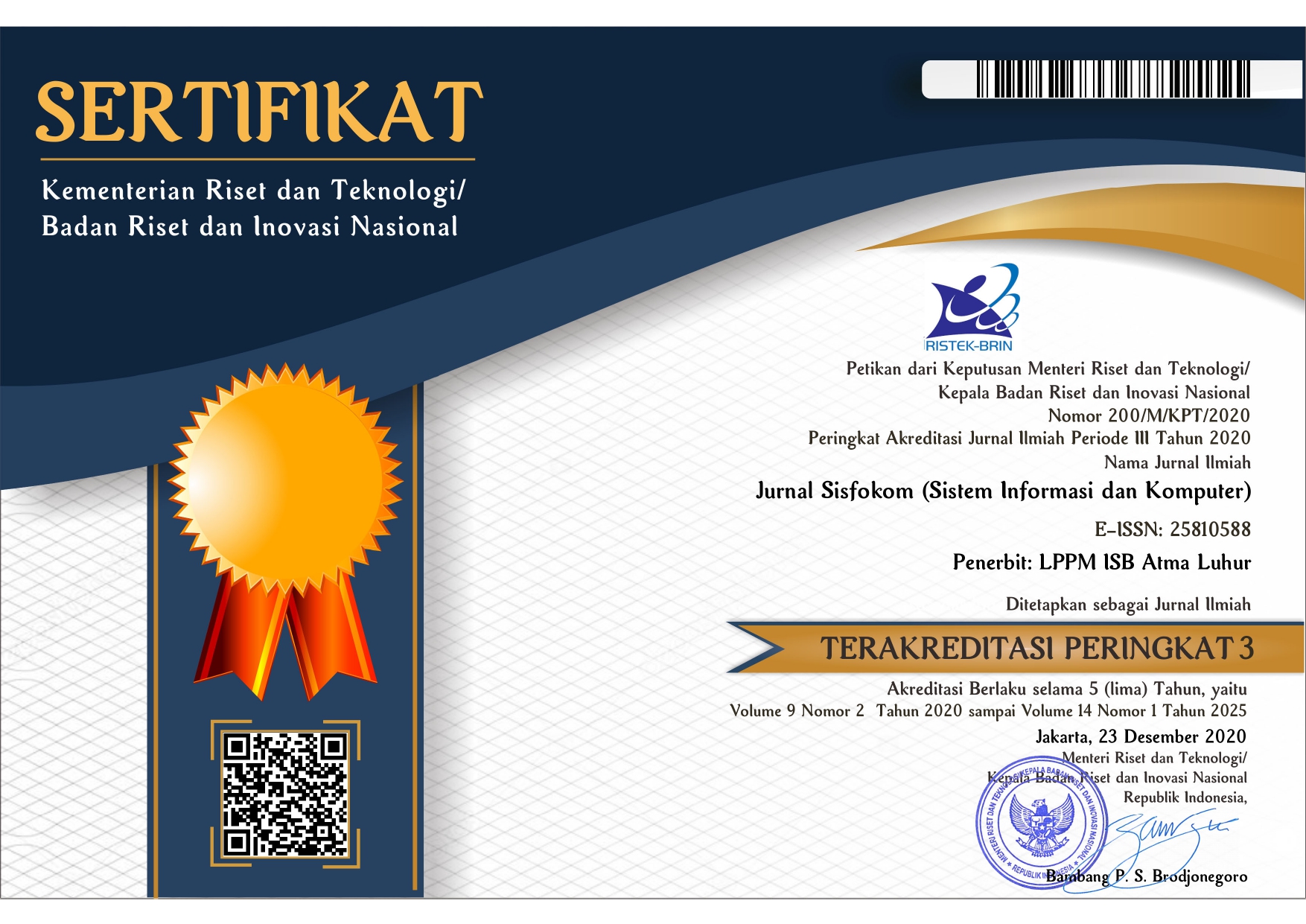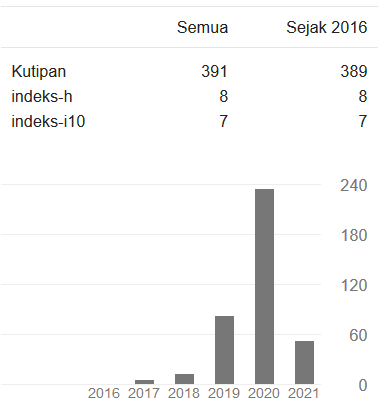Implementasi Analytical Hierarchy Process Dalam Pemilihan Arduino Board
DOI:
https://doi.org/10.32736/sisfokom.v10i1.1034Keywords:
Arduino Board, AHP, Internet Of ThingsAbstract
Internet Of Things (IoT) is one of the trends that is in demand to carry out various automation and control of devices or machines easily anytime and anywhere, the existing Internet Of Things (IoT) devices are of various kinds according to the needs of the One of the users is the Arduino Board. Arduino is a microcontroller board based on the ATmega328P microchip which is used to control various electronic components. Analytical Hierarchy Process is applied in the selection of Arduino board in data calculation and analysis with the addition of Expert Choice software. Primary data collection is by suggesting the criteria used as variables in the assessment. Primary data is obtained from questionnaire data that has been filled in by each respondent. Giving weight of the assessment based on each respondent's data according to the criteria consisting of Cost, Clock Speed, Flash Memory, SRAM, Connectivity, and the number of input / output pins. The result of this study is that the connectivity criteria is the most important criterion for respondents for the Arduino Board assessment, which is 34.2%. For the priority order for the alternative Arduino board, the first is ESP32 of 25.6%, ESP12F of 20%, MCU v3 Node of 19.9%, WEMOS D1 mini of 18.9%, Mega rev3 of 9.9% and the last is uno R3 of 5.7%.References
R. F. Putra, K. M. Lhaksmana, and D. Adytia, “Aplikasi IoT untuk Rumah Pintar dengan Fitur Prediksi Cuaca,” in e-Proceeding of Engineering, 2018, vol. 5, no. 1, pp. 1746–1760.
A. Junaidi, “Internet Of Things, Sejarah, Teknologi Dan Penerapannya : Review,” J. Ilm. Teknol. Inf. Terap., vol. I, no. 3, pp. 62–66, 2015.
G. Turesna, Z. Zulkarnain, and H. Hermawan, “Pengendali Intensitas Lampu Ruangan Berbasis Arduino Uno Menggunakan Metode Fuzzy Logic,” J. Otomasi, Kontrol Instrumentasi, vol. 7, no. 2, pp. 73–88, 2015.
T. Budioko, “Sistem Monitoring Suhu Jarak Jauh Berbasis Internet Of Things Menggunakan Protokol MQTT,” in Seminar Riset Teknologi Informasi (SRITI), 2016, vol. VIII, pp. 353–358.
W. Indianto, A. H. Kridalaksana, and Y. Yulianto, “Perancangan Sistem Prototipe Pendeteksi Banjir Peringatan Dini Menggunakan Arduino Dan PHP,” J. Inform. Mulawarman, vol. 12, no. 1, pp. 45–49, 2017.
F. Faisal and S. D. H. Permana, “Sistem Penunjang Keputusan Pemilihan Sekolah Menengah Kejuruan Teknik Komputer Dan Jaringan Yang Terfavorit Dengan Menggunakan Multi-Criteria Decision Making,” J. Teknol. Inf. dan Ilmu Komput., vol. 2, no. 1, pp. 11–19, 2015.
A. Qashlim, “Penerapan Metode Analytic Hierarchy Process (AHP) Untuk Sistem Pendukung Keputusan (Studi Kasus : Penentuan Kawasan Hutan Konservasi),” J. Ilmu Komput., vol. 1, no. 1, pp. 8–14, 2015.
I. H. Firdaus, G. Abdillah, F. Renaldi, J. Informatika, U. Jenderal, A. Yani, J. Barat, and S. P. Keputusan, “Sistem Pendukung Keputusan Penentuan Karyawan Terbaik Menggunakan Metode AHP Dan Topsis,” in Seminar Nasional Teknologi Informasi dan Komunikasi 2016 (SENTIKA 2016), 2016, vol. 2016, no. Sentika, pp. 18–19.
P. Eva Solita and I. Iskandar, “Sistem Pendukung Keputusan Promosi Jabatan Karyawan Dengan Metode Analytical Hierarchy Process (AHP) Studi Kasus Pada PT. Selular Global Net Medan,” J. Teknol. dan Sist. Inf., vol. 1, no. 2, pp. 71–78, 2015.
K. Safitri, F. T. Waruwu, and Mesran, “Sistem Pendukung Keputusan Pemilihan Karyawan Berprestasi Dengan Menggunakan Metode Analytical Hieararchy Process ( Studi Kasus : PT . Capella Dinamik Nusantara Takengon ),” Media Inform. Budidarma, vol. 1, no. 1, pp. 17–21, 2017.
A. F. Furqon and D. Puspitasari, “Analisis Perbandingan Metode Pembelajaran Kurikulum Tingkat Satuan Pendidikan dengan Kurikulum 2013 Menggunakan Metode AHP,” J. Sist. Inf., vol. 7, no. 1, pp. 98–105, 2018.
A. E. Munthafa and H. Mubarok, “Penerapan Metode Analytical Hierarchy Process Dalam Sistem Pendukung Keputusan Penentuan Mahasiswa Berprestasi,” J. Siliwangi, vol. 3, no. 2, pp. 192–201, 2017.
Frieyadie, “Metode AHP Sebagai Penunjang Keputusan Untuk Penilaian Kinerja Kerja Karyawan SPBU,” J. TECHNO Nusa Mandiri, vol. 15, no. 1, pp. 63–68, 2018.
G. P. Sanyoto, R. I. Handayani, and E. Widanengsih, “Sistem Pendukung Keputusan Pemilihan Laptop Untuk Kebutuhan Operasional Dengan Metode AHP (Studi Kasus: Direktorat Pembinaan Kursus Dan Pelatihan Kemdikbud),” J. Pilar Nusa Mandiri, vol. 13, no. 2, pp. 167–174, 2017.
S. A.M.Pebakirang, A. Sutrisno, and J. Neyland, “Penerapan Metode AHP (Analytical Hierarchy Process) Untuk Pemilihan Supplier Suku Cadang Di PLTD Bitung,” J. Online Poros Tek. Mesin, vol. 6, no. 1, pp. 32–44, 2017.
R. Yanto, “Penerapan Metode Analytical Hierarchy Process dalam Upaya Peningkatan Kualitas Objek Wisata,” Citec J., vol. 4, no. 3, pp. 163–173, 2017.
A. Imanuddin, “Metode Analytical Hierarchy Process Terhadap Keputusan Pemilihan Supplier Dalam Pengadaan Material Canvas Menggunakan Software Expert Choice,” J. Indones. Sos. Teknol., vol. 1, no. 2, pp. 73–81, 2020.
Kusrini, Konsep dan aplikasi sistem pendukung keputusan. Yogyakarta: Andi Offset, 2007.
Downloads
Published
Issue
Section
License
The copyright of the article that accepted for publication shall be assigned to Jurnal Sisfokom (Sistem Informasi dan Komputer) and LPPM ISB Atma Luhur as the publisher of the journal. Copyright includes the right to reproduce and deliver the article in all form and media, including reprints, photographs, microfilms, and any other similar reproductions, as well as translations.
Jurnal Sisfokom (Sistem Informasi dan Komputer), LPPM ISB Atma Luhur, and the Editors make every effort to ensure that no wrong or misleading data, opinions or statements be published in the journal. In any way, the contents of the articles and advertisements published in Jurnal Sisfokom (Sistem Informasi dan Komputer) are the sole and exclusive responsibility of their respective authors.
Jurnal Sisfokom (Sistem Informasi dan Komputer) has full publishing rights to the published articles. Authors are allowed to distribute articles that have been published by sharing the link or DOI of the article. Authors are allowed to use their articles for legal purposes deemed necessary without the written permission of the journal with the initial publication notification from the Jurnal Sisfokom (Sistem Informasi dan Komputer).
The Copyright Transfer Form can be downloaded [Copyright Transfer Form Jurnal Sisfokom (Sistem Informasi dan Komputer).
This agreement is to be signed by at least one of the authors who have obtained the assent of the co-author(s). After submission of this agreement signed by the corresponding author, changes of authorship or in the order of the authors listed will not be accepted. The copyright form should be signed originally, and send it to the Editorial in the form of scanned document to sisfokom@atmaluhur.ac.id.








